Spring in Slovenia is like unlocking a vibrant world just waiting to be explored. There are blue skies, blooming trees and flowers, and busier streets – a welcome change after the long and gloomy winter – some might even say that it is the best time of year to go.
It’s a season that welcomes everyone – whether you’re a nature lover, an adventure seeker, or a food enthusiast. As the snow melts away, Slovenia dons a fresh coat of green, making it an ideal time to visit.
This guide will give you a few ideas on things to do in Slovenia this Spring. Things that I love to do, and also suggestions from my fellow travelers.
Skip Ahead To My Advice Here!
1. The Volčji Potok Arboretum

Visiting the Volčji Potok Arboretum in spring is like stepping into a live gallery of nature’s finest work. Located just a short drive from the busy streets of Ljubljana, this sprawling 80-hectare garden transforms into a riot of colors come spring.
Why spring, you ask? Well, it’s all about the tulips.
Over 2 million tulips are in full bloom, creating a vibrant feast for the eyes. It’s not just about the tulips, though. The Arboretum comes alive with flowering rhododendrons, magnolias, and cherry blossoms, making it a perfect backdrop for a leisurely walk or a family outing.
It’s more than just a pretty place. The Arboretum is a treasure trove for plant enthusiasts or anyone curious about botany, with its vast collection of plants from around the globe.
It’s educational, too. You can learn a lot just by wandering around or joining one of the guided tours. Plus, the place is buzzing with various events and workshops, especially in spring, adding to the lively atmosphere.
So, if you’re looking for a place to relax, enjoy nature, and maybe snap some Instagram-worthy photos, the Volčji Potok Arboretum in spring is a spot you shouldn’t miss. This is nature showing off, and you’re invited to the show.
2. Chase Waterfalls In Slovenia
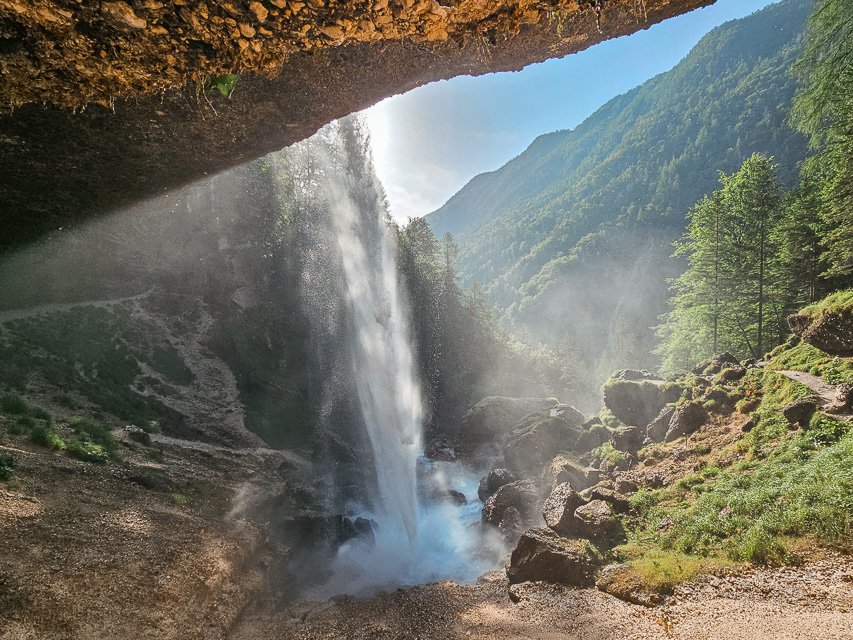
Spring is an excellent time of year to chase some waterfalls, as the spring runoff makes the streams and falls flow strongly. And Slovenia has some incredible waterfalls to experience!
Most of the waterfalls in Slovenia are located in Triglav National Park and the Julian Alps, although there are some others throughout the rest of the country. Most waterfalls in Slovenia require a hike to see and admire the falls, though some hikes are longer and some are just short walks.
Some of the best Slovenian waterfalls include the Kozjak Waterall, the Boka Waterfall, and the Pericnik Waterfall.
The Kozjak Waterfall is a stunning cascade of turquoise water that streams through a cave-like enclosure.
The Boka Waterfall is easily Slovenia’s most enormous waterfall, dropping 136 meters down the sheer side of a mountain. While you can see the Boka Waterfall from the road, if you’re determined enough to do the intense, steep hike up to the waterfall viewpoint, you’ll be rewarded with stunning views over the top of the falls and the surrounding valley.
The Pericnik Waterfall is such a fun one because it falls over a deep rocky overhang, and you can actually walk behind the entire falls. The views from behind are so pretty and so unique!
Of course, there are plenty of other waterfalls, too – the falls at the Source of the Soca are exciting to get to, and the Sum Waterfall is at the end of the fairytale-like Vintgar Gorge hike.
If you’re going to chase waterfalls in Slovenia, you absolutely need your own car, as almost all of these falls are not accessible via public transportation.
Definitely don’t overlook waterfalls on your springtime trip to Slovenia!
3. Reach The High Heights Of The Mountains
Velika Planina

Situated about an hour and a half north of Ljubljana, Slovenia is the enchanting mountaintop herdsman settlement of Velika Planina. At an altitude of over 5,000 feet, the panoramic views of the Alps to the north are breathtaking.
Intrepid hikers can make the steep 2-hour ascent from the small town of Kamnik up the mountainside. Or, just north of town, there is a free parking area with access to the cable car terminal that can take you up the mountain. You can also take a bus or taxi to get there, but no doubt renting a car and driving yourself is more fun.
As the largest highland meadow in Europe, Velika Planina is made for hikers in springtime. The meadows are turning a lush green with large swaths of purple, pink, and yellow springtime wildflowers.
Hike through the settlement to see the fantastic wooden shepherd huts that have existed for centuries. Known as “pastirsko naselje,” these huts are built of wood and roofs made of spruce shingles. There is even a museum dedicated to illustrating the herdsman’s Alpine regions way of life on this high plateau.
Spring is also the time of year when herders bring their cows up to graze on the lush pastures. As you hike, you’ll see these shepherds tending to their herds, with the only sound being the clinking of cowbells.
There are marked and well-trodden trails, but you can wander wherever you like. Hiking through the settlement of huts is a unique and enchanting experience. Be sure to hike past the settlement up to the Chapel of our Lady of the Snows.
Besides immersing yourself in the natural beauty, be sure to stop into the mountaintop restaurant to try some local traditional dairy treats, particularly the Velika Planina cheese. Pair it with freshly baked bread, and you have yourself a picnic with a view that’s hard to beat.
Planina Pod Golico
Each spring, something extraordinary happens on the slopes above Jesenice, the Slovenian industrial town. Many of the typically lush green meadows turn almost entirely snow-white.
The cause of this magical transformation are the blossoms of wild-growing daffodils or narcissi. An annual festival organized in the village of Planina pod Golico marks the springtime arrival of the narcissi.
Each May, visitors from around the country and beyond flock to the area to witness this breathtaking sight. The event culminates when a young damsel is selected to become that year’s “Miss Narcissi.”
4. Enjoy The Wonderful Lakes Of Slovenia
Lake Bohinj

Lake Bohinj, tucked away in the heart of Slovenia’s Julian Alps, is a real gem for anyone looking for a bit of tranquility mixed with natural beauty. It’s the largest permanent lake in Slovenia, and, trust me, it’s a scene straight out of a postcard.
Think crystal-clear waters surrounded by lush forests and towering mountains. It’s quieter than its famous neighbor, Lake Bled, which means you can enjoy a peaceful paddle or swim without bumping into hordes of people as you do in the peak tourist season.
The lake is a starting point for some fantastic hiking trails. Whether you’re up for a leisurely stroll or a challenging trek, there’s something for every kind of outdoor enthusiast.
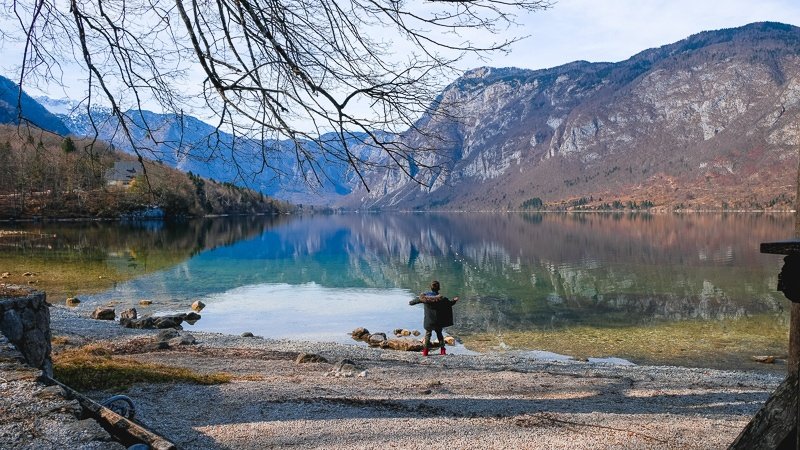
And let’s not forget about the local cuisine – the area around Lake Bohinj serves some seriously good traditional Slovenian dishes that are perfect after a day of exploring.
Come spring, Lake Bohinj transforms into a vibrant hub of life and color. The surrounding meadows burst into bloom, and the warmer weather brings the fairytale landscape to life, making it an ideal time for nature enthusiasts and outdoor adventurers to explore and enjoy.
Whether you’re visiting Slovenia for adventure, relaxation, or a bit of both, Lake Bohinj is a must-visit destination for an unforgettable experience.
Lake Bled
Recommended by The Travel Folk
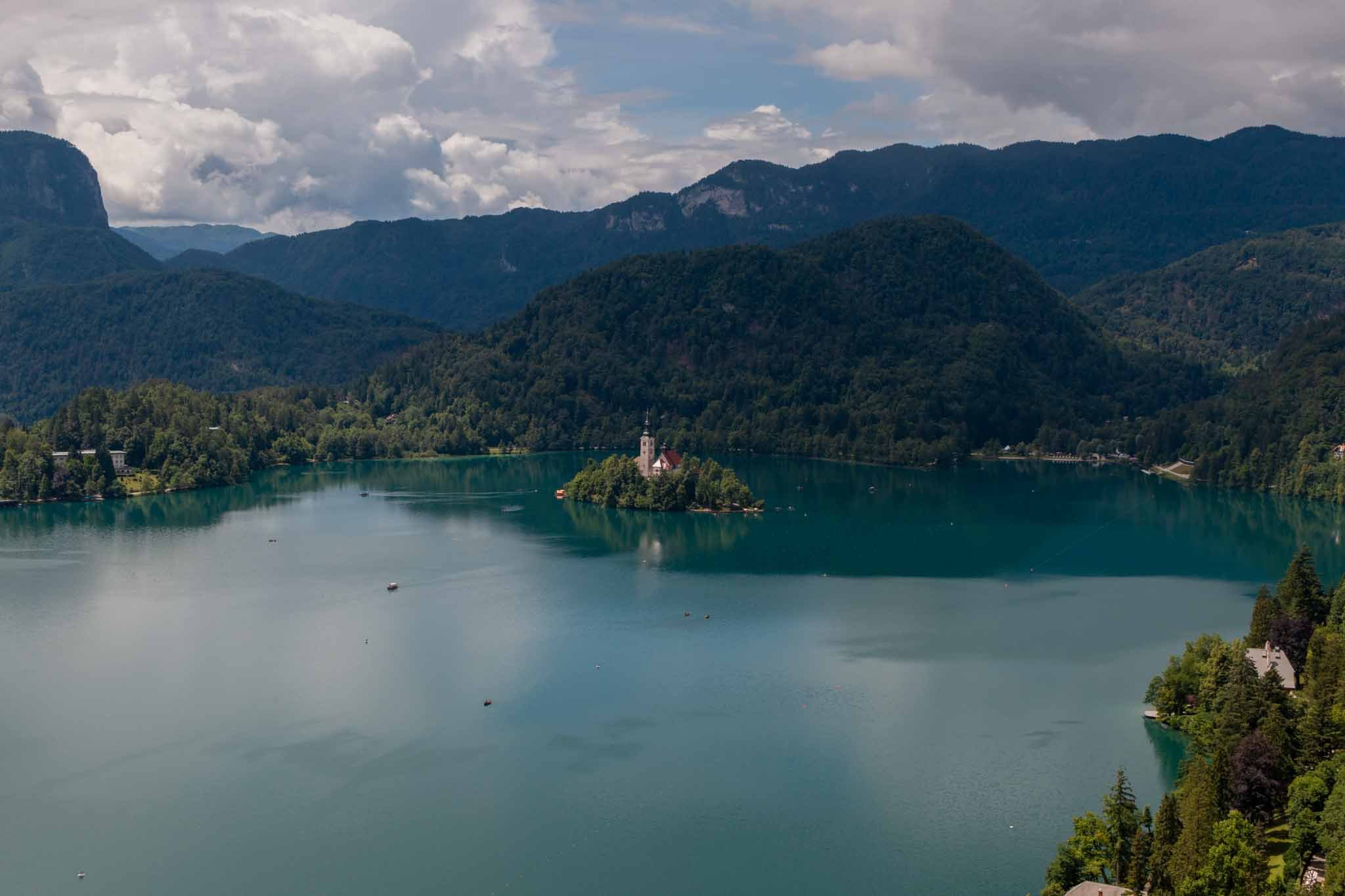
Lake Bled is a stunning glacial lake known for its crystal-clear waters. Located just 55km northwest of Ljubljana, visiting Lake Bled makes for a great day trip from Slovenia’s capital or as a spot to relax for a couple of days and enjoy nature.
One of the most popular things to do on Lake Bled is to visit Bled Island, a tiny island in the center of the lake with a 12th-century church. You can either rent your own rowboat or take a traditional Pletna boat with a group to the island.
For the best views of the lake, head up to Lake Bled Castle, which dates back to the early 11th century. From the castle balcony, you’ll have endless views overlooking the entire lake and the gorgeous green mountains.
If you’re up for a bit of a hike and the weather is nice, walk the path around the entire lake. It’s about 6km long and takes 1.5 hours to complete.
There are a couple of ways to get to Lake Bled. You can either rent a car and drive yourself, which takes 40 minutes from Ljubljana.
The second option is to take a bus from the train station in Ljubljana. The bus ride takes about 1 hour and 20 minutes and costs €5.70 each way.
Brands We Use And Trust
5. Explore The Many Gorges In Slovenia
Vintgar Gorge

Vintgar Gorge is a natural canyon crossing through a nearby forest to Lake Bled. The gorge is famous for its stunning scenery, narrow pathways, wooden walkways, and the Radovna River with its white waters flowing through it. Formed by the erosion of the Hom and Bort hills, Vintgar Gorge offers a scenic and accessible hiking experience.
Vintgar Gorge is closed during the cold season, so if you visit Lake Bled in winter, you will miss seeing it. It reopens in spring when the weather gets better, and hiking there is safe again.
Spring is considered an opportune time to visit, as the weather is generally good, with mild temperatures and increased daylight. Moreover, during spring, Vintgar Gorge tends to have fewer visitors compared to the summer months, providing an opportunity for a more tranquil and peaceful experience.
The end of Vintgar Gorge is marked by an impressive waterfall, which you can descend to on the opposite side of the river.
Getting to Vintgar Gorge is not very straightforward as there is no direct bus. From Bled, you can take a bus halfway there to Spodnje Gorje, or you can walk.
It takes around one hour to reach if you are going by foot.
Further on, after you finish walking through the gorge, you can continue your hike through the forest and do a circular hike to Bled, through the village of Podhom, which is very cute, with typical wooden houses decorated with flowers.
Tolmin Gorge
Recommended by Goya Galeotta
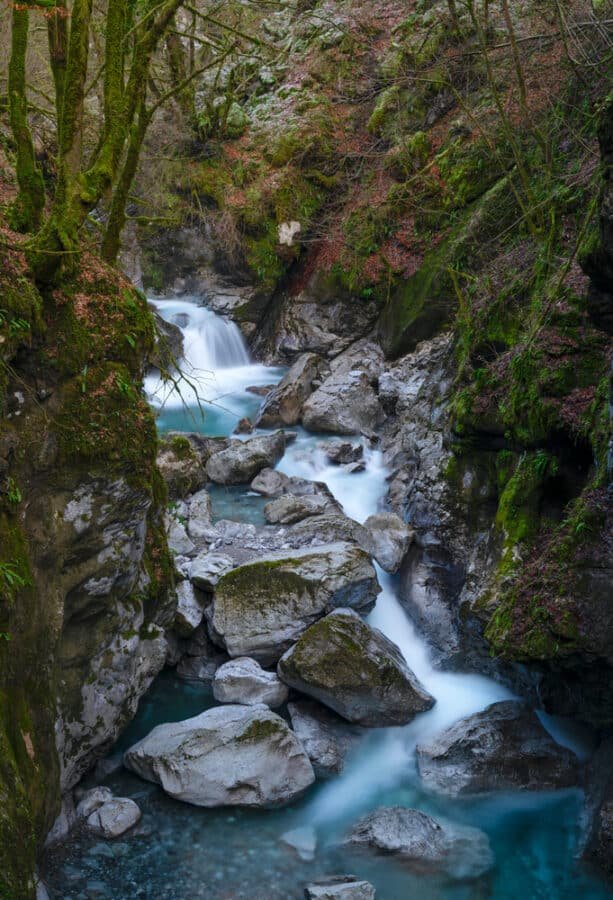
Spring in Slovenia is a shoulder season, falling between the busier summer months and the quieter winter season (except for the dedicated skiing and snowboarding enthusiasts). During this transitional period, nature comes to life with blooming landscapes and milder temperatures, offering a delightful blend of favorable weather without the high season crowds.
This makes it an ideal time to discover the pristine beauty of the Slovenian countryside — like Tolmin Gorge, located at the southern end of Triglav National Park, in a charming town in the upper Soča valley.
When you’re ready to take a break from your exploration of the capital, you can consider this gem for one of the best day trips from Ljubljana. The easiest way to get there? Hop in your car — they’ve got a spacious car park waiting for you at the entrance. But if you’re not up for the driver’s seat, no worries! You can also tag along on a tour.
As you step into Tolmin Gorge, you’re greeted by nature’s grandeur painted in springtime hues. Wooden walkways guide you through the heart of limestone marvels, crystal-clear waters flow beside you, and waterfalls add a symphony to the already mesmerizing surroundings.
Tolmin Gorge is truly a sensory delight! But the adventure doesn’t stop there. You can also ascend a series of steps leading to the Bear’s Head, an intriguing rock formation. Or get a bird’s eye view of the gorge from the famed Devil’s Bridge, a vantage point that offers a breathtaking panorama of this natural masterpiece.
If you’re ready to pack a light lunch, lace up your hiking boots, and let Tolmin Gorge be your springtime sanctuary, remember that this natural gem usually comes to life from March to November after lying dormant throughout the cold winters.
6. Explore The Soča River Valley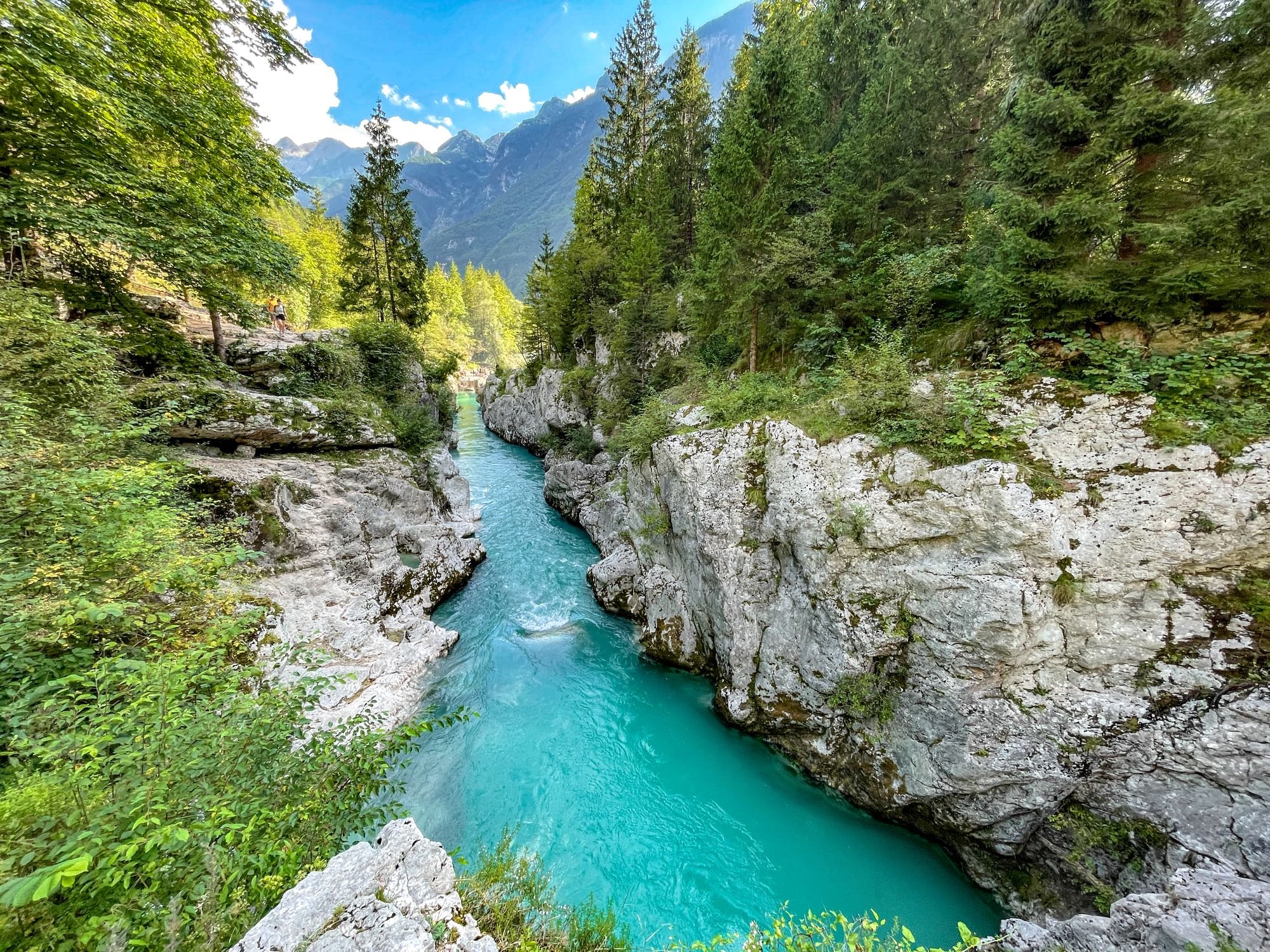
The Soča River Valley is one of Slovenia’s most beautiful and increasingly popular places, making it a great destination in spring. Although many parts of the Soča Valley are available throughout the year, there are several reasons to consider a visit in spring.
Firstly, after the winter cold, experiencing the untouched natural surroundings of the Soča Valley with fresh air, sunshine, and a pleasant environment is the most fulfilling. In spring, vibrant greenery, flowers, abundant waterfalls, and rivers await.
Secondly, in spring, there’s an opportunity to visit the stunning Tolmin Gorge and Kozjak Waterfall, which are otherwise closed in winter.
The only drawback to the Soča Valley is that getting there can be a bit slow. If you’re coming from Ljubljana, you can take the challenging but scenic Vršič Pass or the easier drive from the Italian side, Tarvisio. For public transportation, guided tours are recommended, as reaching the Soča Valley by train or bus can be complicated.
When it comes to the Soča Valley, it’s challenging to highlight just a few main attractions. The most beautiful places include the Great Soča Gorge, the Virje Waterfall near Bovec, a true hidden gem, and the Kozjak Waterfall near the town of Kobarid.
The Soča Valley offers plenty of active recreational opportunities. You can go hiking, rafting, kayaking, canyoning, and even paragliding. This place is a real paradise for nature lovers, photographers, and adventure seekers alike.
Moreover, almost all activities are available in spring, allowing you to avoid the summer crowds!
Additionally, the Soča Valley is filled with historical landmarks, as important battles of World War I took place here. During your trip, you can come across World War I bunkers, old fortresses like the Kluže Fortress, and spectacular memorials such as the Javorca.
In fact, there’s no one I wouldn’t recommend the Soča Valley to as a spring destination in Slovenia. Personally, it’s one of my favorite places to relax, unwind, take photos, and engage in outdoor activities. So, if you’re in Slovenia, don’t miss it; it’s almost guaranteed to provide unforgettable experiences.
7. White Water Rafting In The Soca Or Sava River
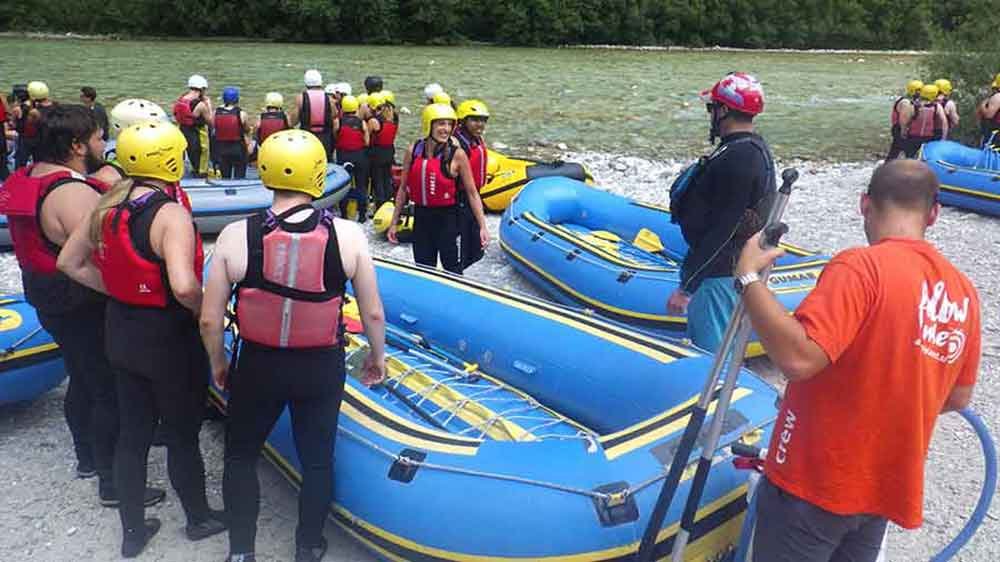
If you’re looking for an adrenaline-fueled adventure in the great outdoors, then I highly recommend rafting in Slovenia, specifically on the sapphire blue Soca or Sava Rivers. Although you can go rafting from spring through to autumn, springtime is one of the best times to go.
The rivers in Slovenia are full from the melting snow and flow swiftly, making your white water rafting experience even more thrilling!
The Soca River features more adventurous Class III and Class IV rapids. These are perfect for anyone whos looking for a more challenging experience and that adrenaline junkies. You’ll get to raft down the stunning blue waters through the breathtaking natural surroundings of the Slovenian countryside.
On the other hand, if you’re searching for something less intense but equally exciting, the Sava River is the better option. It’s not as challenging as the Soca, but it promises an equally refreshing and awe-inspiring journey. It’s the perfect introduction to white water rafting if you’re nervous about traveling as a family.
Organizing your rafting trip is pretty straightforward. Many companies operate rafting tours during the late spring through summer, and some even until late October. They’ll provide you with all the necessary equipment and safety briefings, so you don’t have to worry about anything except maybe holding on tight! Tours can be organized from Beld, Bovec, and Bohinj.
Rafting in Slovenia is suitable for almost everyone with full mobility. You will have to paddle – which is an excellent upper body workout! as well as shift yourself from a seated to a crouched position on the raft. If you fall in, you might also have to swim to the raft.
I highly recommend rafting in Slovenia. It’s one of the most beautiful places I’ve rafted. ? Well, it’s simple. Where else can you combine the thrill of white water rafting with the beauty of unspoiled nature?
8. Odprta Kuhna (Open Kitchen)

This one is not just in spring, but it’s a yummy one! Every Friday from mid-March to October, the Pogacar Square at Ljubljana’s central market is transformed into an “Open Kitchen” filled with food stalls from Slovenia and abroad.
Around thirty restaurants from Ljubljana and other parts of Slovenia showcase their delights side by side while visitors get to pick their favorite.
You can taste Slovenian delicacies or go for Russian, Egyptian, or Thai food. The Open Kitchen has become such a success that it can also be found in other cities around Slovenia, including Koper and Celje.
Check out more details about it here.
9. The Ljubljana Moors
The Ljubljana Moors, a stone’s throw from the urban hustle of Ljubljana, is a refreshing retreat for nature lovers and history buffs alike. Imagine a vast expanse where you can jog, walk, or sit and watch birds and many species of butterflies in their natural habitat.
This nature park isn’t just about scenic beauty; it’s a journey through time. You see, it houses prehistoric pile-dwellings, recognized by UNESCO, offering a window into the lives of Europe’s early farmers, dating back to between 5000 and 500 BC.
What’s fascinating about these wetlands is how they’ve preserved ancient life. Wooden structures, tools, and even remnants of clothing have survived here, providing rare insights into a bygone era. And it’s not just about history.
The Moors are a hotspot for biodiversity, home to a variety of rare species, all thriving in its meadows and fields. Thanks to the Natura 2000 project, much of this area is protected, and these unique habitats are being conserved.
Then there’s the Trnulja estate, just 8 kilometers from Ljubljana, easily reachable by bus. It’s a haven for organic food enthusiasts and those seeking comfy accommodation. The estate blends eco-tourism with culinary delights, offering a range of activities to engage with while enjoying the pastoral setting.
In essence, the Ljubljana Moors offer a blend of natural splendor and historical intrigue, making it a must-visit for those exploring Slovenia.
For more details on planning your visit, check out Visit Ljubljana and Slovenia.info.
10. Visit Kranj

Tucked away between Bled and Ljubljana, Kranj, often overlooked by tourists, is Slovenia’s hidden gem. Come spring, it bursts into life with bright colors and a vibrant vibe. With a beautiful mix of nature and culture, spring is the perfect time to see this gem stand out.
Spring in Kranj is like watching the city wake up from winter slumber. The flowers bloom, the Sava and Kokra rivers sparkle under the lovely spring sun, and the alpine climate air is fresh and cool. It’s the ideal weather for wandering around comfortably without the heat.
Kranj’s old town, filled with medieval buildings, is enjoyable to explore. Stroll along its quaint streets, find secret courtyards, and enjoy the old-world atmosphere.
Khislstein Castle, a 12th-century castle, is now a cultural hub that offers various exhibitions and events. Its garden becomes a peaceful retreat in spring.
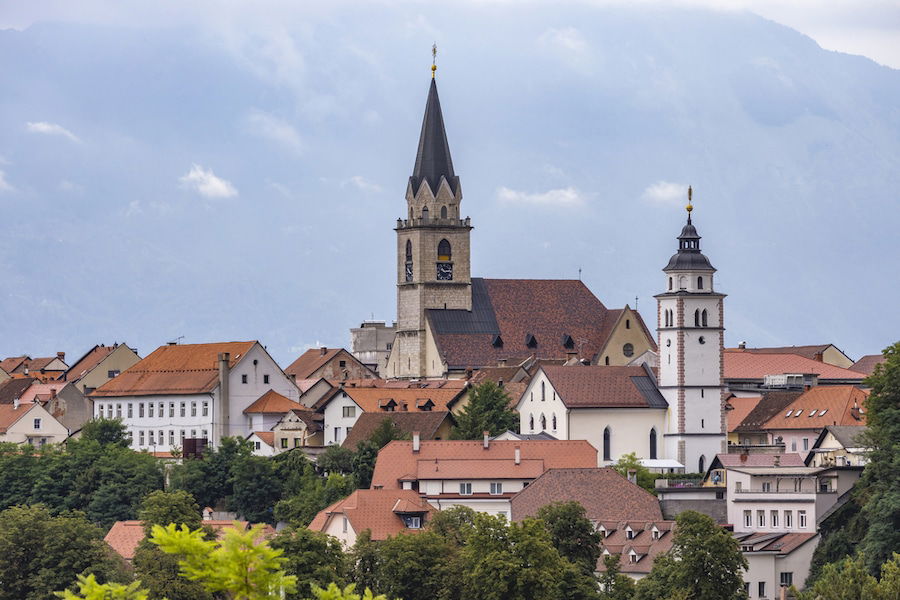
Right at the city’s edge, the Kokra River Canyon is an ideal spot for nature walks. It comes alive in early spring when the sight of the wildflowers and the fragrance of the wild garlic adds to its charm. This slice of wilderness in the middle of the city is also notable for being the second-highest urban gorge in Europe.
You are in for a culinary delight in Kranj, especially with Slovenian cuisine taking center stage in the spring. The city’s cafes and restaurants buzz with life, offering an array of local specialties you must not miss. Be sure to try Kranjska Klobasa, Kranjski štruklji, and Idrijski Žlikrofi. And for the perfect pairing, try them with Kranj craft beer.
Be sure to explore the local events and festivals during spring, as they offer a fantastic insight into local culture. A highlight is the Kranj Carnival, celebrating the transition from winter to spring. This vibrant festival features bright parades, traditional attire, and energetic shows reflecting the region’s rich cultural traditions.
Kranj is a hop and skip away from Slovenia’s capital, Ljubljana, by car or train. Plus, it’s a breeze to get to from Lake Bled, only about 28 km away, making driving or taking a bus super easy. Also, the city’s prime location makes it an excellent starting point for discovering more of Slovenia’s treasures.
11. Discover The Small Town Of Ptuj
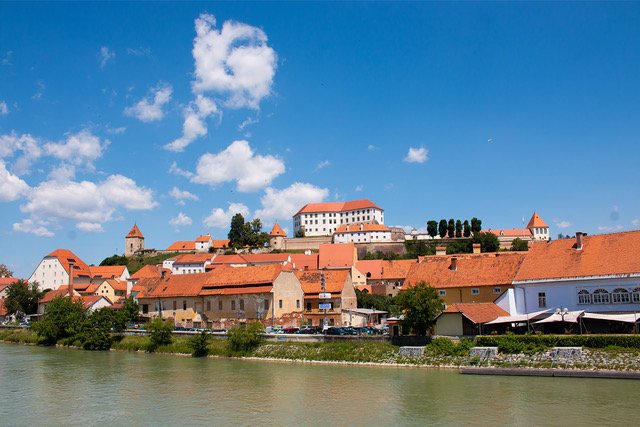
Ptuj is a small town located on the Drava River in eastern Slovenia. It was an important city during the Roman rule over 2000 years ago.
Today, it’s a much smaller town, and it’s mostly known for the castle overlooking the red roofs of the medieval buildings. The castle museum offers various exhibitions.
This includes the permanent castle and history of Ptuj exhibitions, as well as the armory and other temporary exhibitions. You can walk up the cobblestone road to get a panoramic view of the city and the Slovenian countryside.
Two monasteries in downtown Ptuj, a Dominican and a Minorite monastery with manicured gardens, welcome visitors from all over the world. Besides, I recommend a stop at the oldest winery in Slovenia, where the owner will take you on a Slovenian wine exploration tour.
Spring time is also great because the temperatures are still moderate, which is a reason to visit the local thermal park terme. Don’t miss the George’s Fair, which is held at the beginning of spring on April 23 every year. A medieval market with special shows can be experienced on that special day in Ptuj.
The fastest way to get to Ptuj is via Graz (Austria). The drive from Graz to Putj only takes about 75 minutes.
12. Predjama Castle
Recommended by The Endless Travellers

Just 50 minutes from Ljubljana lies a fairytale castle unlike any you may have seen before. Situated deep within a cave, surrounded by a 123m cliff, overlooking rolling fields in the Slovenian countryside, sits the must-see Predjama Castle.
This 800-year-old marvel is the world’s largest castle within a cave, where the knight Erazen of Predjama once lived. Not only is there a stunning castle to explore, but behind the castle lies an intricate maze of secret tunnels that you can enter in order to appreciate the sheer magnitude of the passageways.
Predjama Castle really is the ultimate place to immerse yourself in the beauty of spring in Slovenia while learning more about its fascinating past.
Entrance to the castle will set you back just 19,00 €, allowing you to explore within the castle itself, as well as the entrance to the cave. Heading inside, an audio tour will describe to you the fascinating history of each room within Predjama Castle, with a variety of medieval weapons and furniture on display.
Make sure to find the closest window, where you will be rewarded with amazing panoramic views of the beautiful meadows that surround Predjama Castle, blooming with spring flowers. The views are honestly incredible; you’ll feel as if you’re the only person for miles.
No trip to Predjama castle would be complete without visiting the cafe adjacent to the entrance where you can treat yourself to some traditional Bled cake. You won’t regret it!
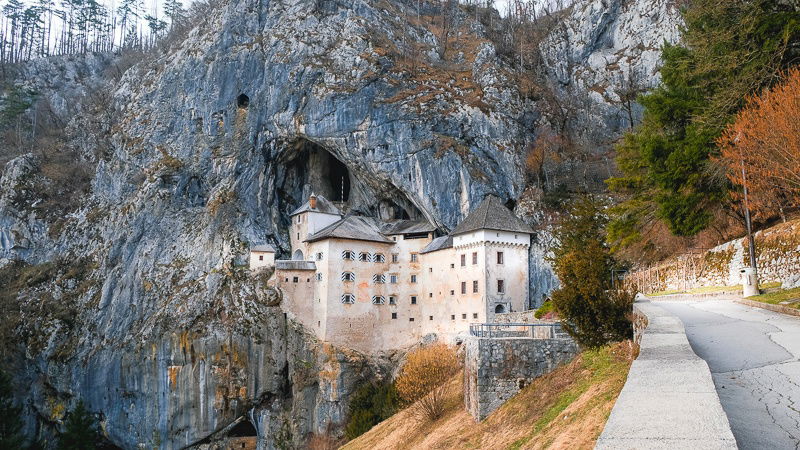
How To Get To Predjama Castle
Predjama Castle is very easy to reach, especially if you’re driving yourself. From Ljubljana, it takes just 50 minutes to reach Predjama Castle. If you’re staying closer to Lake Bled, expect it to take 1hr 15 minutes.
If you’re traveling by public transport, you’ll want to catch a train from Ljubljana to Postojna, then either hop into a taxi or catch the bus for the final 20 minutes. The whole journey will take around 1 hour and 30 minutes this way.
Opening Times
Predjama Castle is open throughout spring.
Here are the month-by-month opening hours:
- January – March & November – December: 10:00-16:00
- April & October: 10:00 – 17:00
- May, June & September: 9:00 – 18:00
- July & August: 9:00 – 19:00
13. Sečovlje Saltpans
Not far from Piran, one can find Sečovlje salt pans measuring 650 hectares and where salt is traditionally produced—the tradition of salt-making dates back to the 14th century. On average, 2,000 tons of salt is harvested each year. Salt pans are also home to almost three hundred bird species.
In 2001, the Sečovlje Salina Nature Park and the Museum of Salt-making were proclaimed a cultural monument of national importance.
Move This Adventure To Your Inbox & Get An Instant Freebie

No spam. Unsubscribe at any time.
14. Brdo Estate
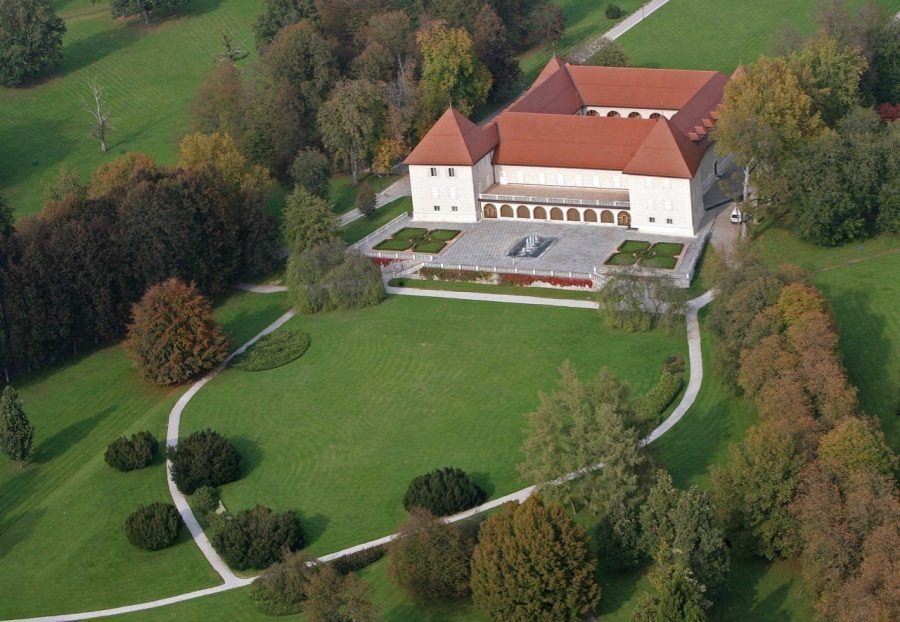
The Brdo Estate near Slovenia’s fourth-largest city, Kranj, represents a unique blend of history, nature, culture, and architecture. The Brdo Castle is a 500-year-old mansion that has served as home for many prominent people, including Yugoslav President Josip Broz Tito and the Serbian Karadordevic Royal Family.
Today, Brdo Castle is the most crucial diplomatic protocol building in the country. Part of the Brdo Estate is also Brdo Park. More than 70 hectares of meadows, lakes, and forests represent an excellent place to relax in Slovenia this spring.
Want to explore more castles? Then, you can find even more castles in Slovenia here.
15. Logar Valley & Rinka Waterfall
Pictures of the Logar Valley can be found in numerous tourist brochures, mostly in springtime, and for a good reason. A winding road with a view of the mountains of the Kamnik-Savinja Alps is genuinely captivating.
Due to its many natural sights, the seven-kilometer- long valley is protected as a nature park and is an excellent starting point for family walks, hiking trips, and longer active vacations in pristine nature.
The central star of the valley is the Rinka waterfall, with its magnificent view and gorgeous meadows. It falls over a wide wall and is the second-highest waterfall in Slovenia at 105 meters.
The Savinja stream, the primary water source of the Rinka Waterfall springs, comes from numerous sources below the Okrešelj Basin. It flows over a series of small step-like falls and rapids to the cliff-like edge of the glaciated Logarska Dolina Valley. The water goes underground soon after the waterfall, and it comes back out to the surface in the lower section of the valley, at the source of Črna.
If you can’t make it during spring, hikers also enjoy visiting during winter, as alpinists climb on the frozen waters and ski close by.
From the Solcava to Logarska Dolina, you can ride a bus to the Rinka Waterfall. Disembark at the parking lot at the end of the asphalt road. From there, it is a 15-minute walk to the waterfalls.
Local Tip: Grab a drink at Eagle’s Bar (Orlovo Gnezdo) right by the waterfall.
16. Goriška Brda
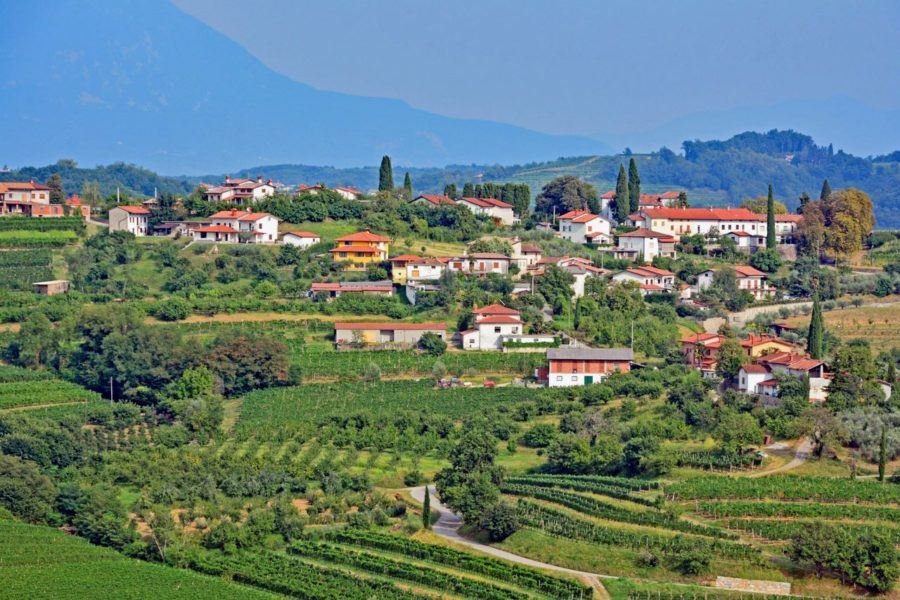
Slovenia’s region of Goriška Brda is known as Slovenian Tuscany. This southwestern part of the country has a very long winemaking tradition, and some are convinced that the best wines are made in Brda.
The gentle climate assures excellent growing conditions for grapes and other fruits such as peaches, cherries, and apricots. What makes Brda so special are the picturesque villages, such as Šmartno, which is one of the best-preserved medieval villages in Slovenia. Make sure to visit Dobrovo Castle as well. The castle dates back to the 17th century and houses different marquises, counts, and noble families.
17. Food Walk In Ljubljana
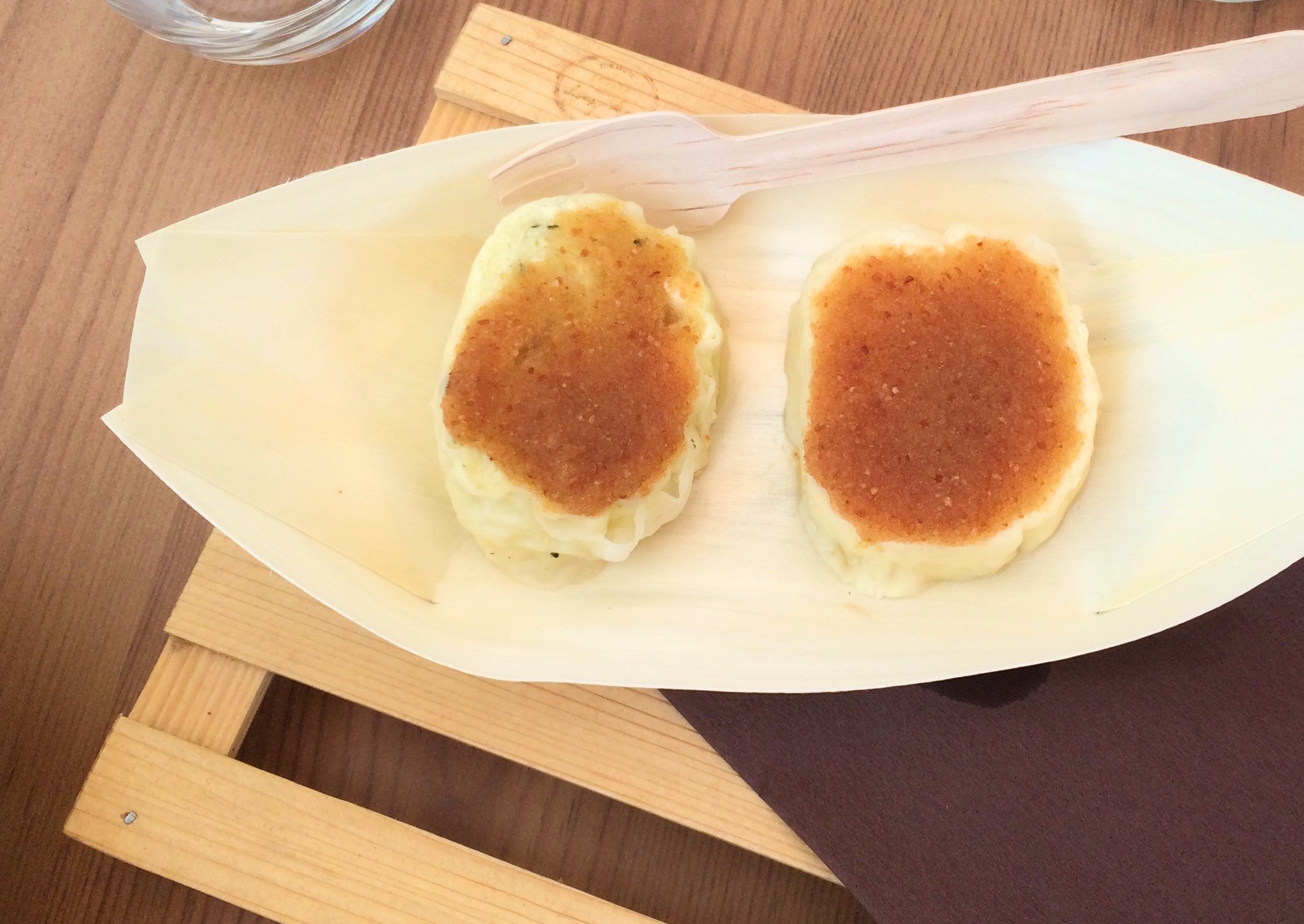
If you get a chance to visit Slovenia in springtime, do visit its lovely capital city, Ljubljana. The town center is perfect for walking around and exploring its colorful buildings. We spent half a day doing a fabulous food tour in Ljubljana.
This was a small-group culinary walk that also gave us insight into the recent history of Slovenia and how it was part of the former Yugoslavia. It was a great introduction to both traditional and modern Slovenian food. Slovenian food is heavily influenced by German, Austrian, Italian, and Hungarian cuisines.
We tried some traditional food dishes like Jota (traditional cabbage stew) and Struklji (dumplings with different fillings). And Potica, which is part of the Slovenian food heritage.
The walking food tour ended with a taste of modern Slovenian cuisine based on our individual preferences for vegetables, fish, and meat. We also had pumpkin seed oil and craft beer that is produced in the country. I highly recommend a food walk if you are figuring out what to do in Ljubljana.
Apart from food tasting, we passed by some interesting structures in the Slovenian capital, Ljubljana town center, including the Ljubljanica river that flows through the city, Triple Bridge, Butcher’s Bridge, and some colorful local markets.
Our tour guide and fellow travelers conversed easily during this afternoon. Even my six-year-old daughter enjoyed the food walk.
Final Word On Springtime In Slovenia
In wrapping up, it’s clear that this beautiful country truly shines during one of its best seasons with fewer crowds. Spring in Slovenia, with its continental climate, brings about warm weather and sunny skies, setting the perfect stage for a range of outdoor adventures.
Whether you’re trekking through the lush national parks or seeking a crowd-free getaway in some less explored part of Slovenia, the opportunities are diverse and offer many unique experience options.
What’s particularly appealing about visiting Slovenia in spring is how the season gradually unfolds. By late June, you’re experiencing the full vibrancy of Slovenian spring – the landscapes are alive, the weather is inviting, and the list of what to do in Slovenia seems endless.
From leisurely strolls in blooming gardens to heart-pumping activities in the great outdoors, there’s something for every kind of traveler.
Remember, the charm of Slovenia in spring isn’t just in the popular spots; it’s also found in the quiet corners of the country where you can enjoy the season away from the crowds. Whether you’re a repeat visitor or planning your first trip, spring in Slovenia is a time of discovery and enjoyment.

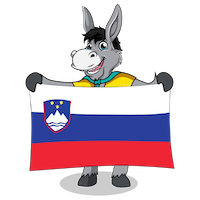

Wow! Your information is mind blowing and I’m thrilled to find you! I am wondering first if we will be able to drive easily around Slovenia in the middle of March when we are planning a trip to there and Croatia? We’d like to visit all around both countries and drive most of Slovenia but we don’t know about the weather at that time of year. Will we encounter snow and ice in the lower elevations or travelling between the major sights and back to Croatia? We’re from Northern Minnesota in the U.S. so in March there’s always that possibility! Thank you so much! Jean Schwengler
Must Visit!
Are dogs permitted in Slovenia?
Yes, dogs are generally permitted in Slovenia. However, regulations regarding dogs may vary depending on the specific location and circumstances. In public places, dogs are usually required to be on a leash, and owners are expected to clean up after their pets.